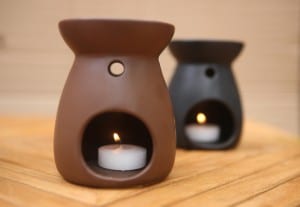Stephanie is a firm believer in the healing power of showers. Hot water, steam and a little aromatherapy can make anything, and I seriously mean anything, better. Stephanie finally took her own advice and hit the shower for an aromatic eucalyptus steam session. Eucalyptus and steam are the only things that actually made her feel better without that foggy feeling you get with meds. Not only was it relaxing but it was a whole lot cheaper, too!
Here’s how to make your own aromatherapy steam room with nothing more than fresh eucalyptus and a hot shower.
Eucalyptus is a godsend when it comes to relieving cold symptoms and healing respiratory issues. Fresh eucalyptus has antiseptic and anti-inflammatory properties that can help kill germs and open up the airways in your nose and throat. And by combining eucalyptus with steam, it’ll help break up mucus, relieve sinus pressure and soothe nasal passages so you can breathe more easily.
To turn your bathroom into a sinus-clearing steam room, simply buy a few branches of fresh eucalyptus from a local grocery store or florist. There are a couple different kinds of eucalyptus at Trader Joe’s for cheap, but you’ll want to use baby blue eucalyptus (as opposed to the silver dollar variety) if you can find it. It’s the most fragrant and it has the strongest antiseptic properties of all the Eucalyptus.
Once you’ve purchased your branches, gather them together and tie them tightly at the base with string or baker’s twine. Then tie the bundle around your shower head. You’ll want to position it so it sits in between the wall and the stream of water, not in the water itself. Lastly, shut the door, turn on the shower and let the bathroom fill with steam.
How to take a eucalyptus shower
Ingredients
- 2 bunches fresh baby blue eucalyptus
- String or baker’s twine
- Shower
Instructions
- Remove any plastic packaging from your eucalyptus.
- Gather the branches together and tie them tightly at the base with string.
- Using a second piece of string, tie the bundle around the shower head between the wall and stream of water.
- Turn the shower on high and let the steam fill the room. Take long slow breaths until you start to notice your congestion dissipating.
- Leave the eucalyptus in the shower for up to a week (or until it starts to dry out and fall apart), then replace with a fresh bundle.
Aromatherapy essential oils can be used in a variety of ways at home, such as in body lotions or massage oil. Eucalyptus oil, one of the more popular essential oils, is often used to ease congestion and other cold symptoms. It is said to work best when it is combined with some form of steam inhalation. Here are several common ways to use it:
1) Eucalyptus Oil in a Bath
Using eucalyptus oil in a warm bath or shower is the easiest way to create an at-home steam inhalation. To do it, you would add two to three drops of the essential oil to your bath just before getting in.
2) Eucalyptus Oil in a Bowl of Warm Water
Another method involves adding a drop of eucalyptus oil to a mug or small bowl of hot water and standing over the bowl for a short period so that you can gently inhale the eucalyptus-infused steam.
To try a steam inhalation, you would place one to two drops of eucalyptus essential oil in a bowl of hot water. (The bowl should be on a stable surface and out of reach of children and pets.) With your head at least an arm’s length away from the bowl, you would put a towel over your head to focus the steam.
Closing your eyes and breathing in would allow the vapor to enter your nose. Regular breaks (stopping immediately if you feel overheated or uncomfortable) are recommended, and it shouldn’t be done for more than five to ten minutes.
Eucalyptus Essential Oil, distilled from the Australian native Eucalyptus globulus tree, boasts a long list of traditional uses. Aboriginal Australians used Eucalyptus to heal wounds, cure fungal infections, and as a fever reducer. Chinese, Greek, European, and Ayurvedic medicine later adopted Eucalyptus as a disinfectant and expectorant.
Present day medicinal applications of Eucalyptus Oil may be seen in the majority of grocery stores and pharmacies around the world including the oil’s use in vapor chest rubs, over-the-counter cough and cold medications, sore throat sprays, topical pain relievers just to name a few. (UMMC)
In the following list, we’ll reveal the top ten health benefits and uses of Eucalyptus Oil as well as some recipes and tips on how to use this versatile essential oil.
1. Sinus Decongestant
Use Eucalyptus Oil to relieve sinus congestion by adding a few drops of the oil to hot water and inhaling the steam. Just remember to close your eyes the entire time your face is over the water to avoid burning them with the powerful Eucalyptol fumes. Follow the guide provided by UMMC for the appropriate dilution ratio of Eucalyptus Oil to water.
Eucalyptus Oil may also be applied topically diluted in a carrier oil as a chest rub for extended relief of upper respiratory congestion and other symptoms. (Check out this great recipe by Heather, the Mommypotamus!)
(Further reading: 14 Powerful Natural Remedies For A Sinus Infection)
2. Control Coughing
Eucalyptol, the active ingredient in Eucalyptus Oil can also help to control a cough. (PubMed)
Again, steam inhalation is an effective method to loosen mucus and facilitate its removal from the body. Eucalyptus Oil chest rubs are another effective remedy for this purpose. Also, you may want to take Eucalyptus lozenges throughout the day to manage your cough between steam treatments.
3. Joint & Muscle Pain Reliever
 Prepare Eucalyptus Oil as a cream or warming balm for topical application to soothe sore joints and muscles. (PubMed)
Prepare Eucalyptus Oil as a cream or warming balm for topical application to soothe sore joints and muscles. (PubMed)
Follow this recipe by onegoodthingbyjillee.com to make your own homemade pain relieving cream using Coconut Oil, Beeswax, Camphor, Menthol Crystals, and Eucalyptus Essential Oil.
Or learn how to make a DIY warming rub for sore muscles using Eucalyptus Oil and a few other all-natural ingredients from Mommypotamus.
(Further reading: 10 Potent Foods That Kill Pain Fast)
4. Sore Throat Spray
Eucalyptus Oil is anti-bacterial, in addition to being excellent for pain relief. To help reduce pain and swelling of a sore throat, try this recipe for a DIY soothing throat spray, compliments of ohlardy.com using all natural ingredients including Pure Himalayan Salt and the Four Thieves Synergy Blend (essential oils of Clove, Cinnamon Bark, Lemon, Rosemary, and Eucalyptus.)
Alternately, you can buy pre-mixed Organic Herbal Sore Throat Spray with Eucalyptus on Amazon.com.
5. Disinfecting Cleanser
Eucalyptus Oil is a powerful anti-microbial, making it ideal for preventing the spread of bacterial and viral infections, as well as for general cleaning. (Wiley Online Library)
Mix Eucalyptus Oil with Castile Soap for an all-natural disinfecting powerhouse. Also, be sure to read How To Replace 10 Household Products With Castile Soap for more great natural cleaning tips and recipes.
Remember that pure Eucalyptus Oil can easily burn sensitive skin. If you intend to use this antimicrobial oil topically, be certain to dilute it in a carrier oil before applying it to your skin – especially for dry, irritated, or sensitive areas.
6. Dental Anti-microbial
Anti-microbial Eucalyptus Oil is perfect for killing germs in mouth, reducing plaque, and helping to prevent gum disease. (PubMed)
Mix your own Eucalyptus Mouthwash using this great guide by BreathMD.
Also you may want to try out this DIY Eucalyptus Toothpaste recipe, compliments of simplegreensmoothies.com.
6 tbsp Coconut Oil
6 tbsp Pure Aluminum-Free Baking Soda
25 drops Eucalyptus Essential Oil
1 tsp (approx.) Stevia powder
1. Mix all ingredients together in a bowl. (Jen Hansard of simplegreensmoothies.com recommends whipping the ingredients together with a SmartStick to get a good creamy toothpaste texture.) Then pour the mixture into a resealable glass jar and store it in your bathroom cabinet until it’s time to brush your teeth.
Because coconut oil is solid at room temperature, you may need to use a butter knife or popsicle stick to get your homemade paste from jar to toothbrush.
Remember that Eucalyptus Oil is toxic if swallowed in large enough quantities. For this reason, oral care products containing Eucalyptus oil are not recommended for small children.
(Further reading: 24 Baking Soda Uses & Why You Need It In Your Home!)
7. Immune Stimulant
Eucalyptus Oil is known to increases phagocytic activity, meaning that it can be used to boost the immune system. (PubMed)
If you’re concerned at all about getting sick during cold and flu season or if you know you’re going to be exposed to people who may already by carrying a bug, prepare yourself with Eucalyptus Oil by itself or with the Four Thieves Synergy Blend (essential oils of Clove, Cinnamon Bark, Lemon, Rosemary, and Eucalyptus.)
Aromatherapist KG Stiles of kgstiles.com recommends using Eucalyptus as an inhalant or in your diffuser to deliver the healing vapors directly into your circulatory system via the lungs. For more information on using Eucalyptus Oil for immune support, check out her expert article on the topic.
8. Asthma Relief
Due to the anti-inflammatory properties of Eucalyptol, use of Eucalyptus Oil has been studied and confirmed to be effective in the treatment of Bronchial Asthma. (resmedjournal.com)
Use Eucalyptus Oil either by inhalation or in a diffuser to help reduce inflammation and clear congestion from airways. Again, it is important to remember that Eucalyptus oil is toxic when taken internally.
Please Note: No herbal remedy is meant to take the place of prescribed medications.
Always consult with your doctor first before using herbal remedies containing Eucalyptus to treat Asthma as this oil is known to have adverse interactions with some Asthma medications.
(Further reading: 8 Ways To Purify Home Air Naturally So Your Family Can Breathe The Healthiest, Cleanest Air Possible)
9. Insect Repellent
Eucalyptus Oil can be effectively used either as an area treatment or as part of a topical insect-repelling spray. (EPA R.E.D. Facts)
Try out this All-Natural Bug Spray Recipe using Witch Hazel as well as essential oils of Citronella, Lemongrass, Rosemary, Eucalyptus, and Peppermint.
For more all-natural insect-repelling ideas, be sure to read up on these 13 Natural Ways To Keep Mosquitoes Away and 22 Natural Ways To Repel Insects.
10. Aroma-therapeutic
 Last, but definitely not least – Eucalyptus Oil provides a wonderful aromatherapy experience. Eucalyptus is refreshing and powerfully stimulating. Use Eucalyptus Oil in your diffuser or create scented room fresheners by adding a few drops of oil to a hanging object. This oil is perfect for boosting concentration and keeping your energy level elevated. Use Eucalyptus Oil on a rainy or cloudy day to clear the fog and lift your spirits.
Last, but definitely not least – Eucalyptus Oil provides a wonderful aromatherapy experience. Eucalyptus is refreshing and powerfully stimulating. Use Eucalyptus Oil in your diffuser or create scented room fresheners by adding a few drops of oil to a hanging object. This oil is perfect for boosting concentration and keeping your energy level elevated. Use Eucalyptus Oil on a rainy or cloudy day to clear the fog and lift your spirits.
(Craving more essential oil goodness? We’ve got you covered with 50 Magical Ways To Use Essential Oils To Improve Your Life around the home, at the office, and even in your car!)
Precautions
Use of herbal remedies may have side effects. Herbal remedies frequently interact with other herbs, supplements, or medications and these interactions can be very dangerous. Before using any herbal remedies containing Eucalyptus, it is strongly recommended to consult with a medical professional, especially if you are prone to seizures, liver or kidney disease, low blood pressure.
Always consult with your doctor before using Eucalyptus oil to treat asthma.
Pregnant and breastfeeding women should avoid using Eucalyptus oil.
Eucalyptus oil is toxic if swallowed in large enough quantities. Adults should exercise caution when using Eucalyptus oil for oral care.
Eucalyptus oil or products (chest rubs, salves, etc) should not be applied to children under 6 years of age. Also, children should not be allowed to use eucalyptus oil for oral care. Eucalyptus oil lozenges should not be administered to children under 6 years of age. When in doubt, consult with your pediatrician before using eucalyptus oil or products containing eucalyptus to treat children. (Source: UMMC.)
Janice Taylor







 Cold and Flu Remedy #1: Cayenne: Sore Throat Solution
Cold and Flu Remedy #1: Cayenne: Sore Throat Solution


